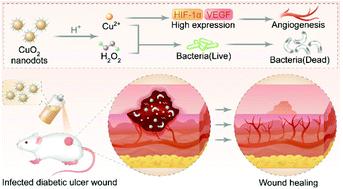Our official English website, www.x-mol.net, welcomes your
feedback! (Note: you will need to create a separate account there.)
Sprayed copper peroxide nanodots for accelerating wound healing in a multidrug-resistant bacteria infected diabetic ulcer
Nanoscale ( IF 5.8 ) Pub Date : 2021-08-25 , DOI: 10.1039/d1nr04687j Ran Zhang 1 , Guhua Jiang 1 , Qianqian Gao 2 , Xiaona Wang 3 , Yilin Wang 1 , Xin Xu 1 , Wenjing Yan 1 , Haijun Shen 1
Nanoscale ( IF 5.8 ) Pub Date : 2021-08-25 , DOI: 10.1039/d1nr04687j Ran Zhang 1 , Guhua Jiang 1 , Qianqian Gao 2 , Xiaona Wang 3 , Yilin Wang 1 , Xin Xu 1 , Wenjing Yan 1 , Haijun Shen 1
Affiliation

|
Vascular dysfunction and bacterial infection are key factors for the non-healing of diabetic ulcers. Growth factors and antibiotics seem to effectively target both issues. However, the short half-life and high cost of growth factors and the antibiotics resistance of bacteria greatly limit their further widespread applications. Novel strategies or agents with both angiogenic and antibacterial activities are urgently desirable. Copper peroxide (CuO2) nanodots were reported to be decomposed into Cu2+ and H2O2 under mild acid conditions (pH 5.5). Considering that both decomposed products are acknowledged antibacterial agents (Cu2+, H2O2) and angiogenesis activator (Cu2+), we believe that CuO2 nanodots are suitable for diabetic ulcer treatment because the pathological environment of infected chronic wounds is mildly acidic with pH 5.5–5.6. As expected, in vitro experiments showed that CuO2 nanodots possessed excellent bactericidal properties against Escherichia coli, Staphylococcus aureus, Pseudomonas aeruginosa, and even methicillin-resistant Staphylococcus aureus (MRSA). CuO2 nanodots induced the high expression of hypoxia-inducible factor (HIF-1α) and vascular endothelial growth factor (VEGF) in human umbilical vein endothelial cells (HUVECs), subsequently promoting the cell migration and tube formation for angiogenesis. In particular, CuO2 nanodots exhibited good dispersibility and sprayable behavior in water. In vivo experiments demonstrated that the spayed CuO2 nanodots in the wound area could effectively combat MRSA, reduce inflammation, promote angiogenesis, and consequently accelerate wound healing. Moreover, the sprayed CuO2 nanodots in the wound sites caused negligible system toxicity. This study provides proof-of-principle evidence for applying the sprayed CuO2 nanodots for infected diabetic ulcer treatment.
中文翻译:

喷雾过氧化铜纳米点可加速多药耐药细菌感染糖尿病溃疡的伤口愈合
血管功能障碍和细菌感染是糖尿病溃疡不愈合的关键因素。生长因子和抗生素似乎有效地针对这两个问题。然而,生长因子的半衰期短、成本高以及细菌对抗生素的耐药性极大地限制了它们的进一步广泛应用。迫切需要具有血管生成和抗菌活性的新策略或药物。据报道,过氧化铜 (CuO 2 ) 纳米点在温和的酸性条件下(pH 5.5)分解为 Cu 2+和 H 2 O 2。考虑到这两种分解产物都是公认的抗菌剂(Cu 2+ , H 2 O 2) 和血管生成激活剂 (Cu 2+ ),我们认为 CuO 2纳米点适用于糖尿病溃疡治疗,因为感染的慢性伤口的病理环境为弱酸性,pH 值为 5.5-5.6。正如预期的那样,体外实验表明,CuO 2纳米点对大肠杆菌、金黄色葡萄球菌、铜绿假单胞菌,甚至耐甲氧西林金黄色葡萄球菌(MRSA)具有优异的杀菌性能。氧化铜2纳米点诱导人脐静脉内皮细胞 (HUVEC) 中缺氧诱导因子 (HIF-1α) 和血管内皮生长因子 (VEGF) 的高表达,从而促进细胞迁移和血管生成的管形成。特别是,CuO 2纳米点在水中表现出良好的分散性和可喷涂性。体内实验表明,在伤口区域喷射的CuO 2纳米点可以有效地对抗MRSA,减少炎症,促进血管生成,从而加速伤口愈合。此外,在伤口部位喷洒的CuO 2纳米点引起的系统毒性可以忽略不计。本研究为应用喷涂的 CuO 2提供了原理验证证据 用于治疗感染性糖尿病溃疡的纳米点。
更新日期:2021-09-15
中文翻译:

喷雾过氧化铜纳米点可加速多药耐药细菌感染糖尿病溃疡的伤口愈合
血管功能障碍和细菌感染是糖尿病溃疡不愈合的关键因素。生长因子和抗生素似乎有效地针对这两个问题。然而,生长因子的半衰期短、成本高以及细菌对抗生素的耐药性极大地限制了它们的进一步广泛应用。迫切需要具有血管生成和抗菌活性的新策略或药物。据报道,过氧化铜 (CuO 2 ) 纳米点在温和的酸性条件下(pH 5.5)分解为 Cu 2+和 H 2 O 2。考虑到这两种分解产物都是公认的抗菌剂(Cu 2+ , H 2 O 2) 和血管生成激活剂 (Cu 2+ ),我们认为 CuO 2纳米点适用于糖尿病溃疡治疗,因为感染的慢性伤口的病理环境为弱酸性,pH 值为 5.5-5.6。正如预期的那样,体外实验表明,CuO 2纳米点对大肠杆菌、金黄色葡萄球菌、铜绿假单胞菌,甚至耐甲氧西林金黄色葡萄球菌(MRSA)具有优异的杀菌性能。氧化铜2纳米点诱导人脐静脉内皮细胞 (HUVEC) 中缺氧诱导因子 (HIF-1α) 和血管内皮生长因子 (VEGF) 的高表达,从而促进细胞迁移和血管生成的管形成。特别是,CuO 2纳米点在水中表现出良好的分散性和可喷涂性。体内实验表明,在伤口区域喷射的CuO 2纳米点可以有效地对抗MRSA,减少炎症,促进血管生成,从而加速伤口愈合。此外,在伤口部位喷洒的CuO 2纳米点引起的系统毒性可以忽略不计。本研究为应用喷涂的 CuO 2提供了原理验证证据 用于治疗感染性糖尿病溃疡的纳米点。











































 京公网安备 11010802027423号
京公网安备 11010802027423号